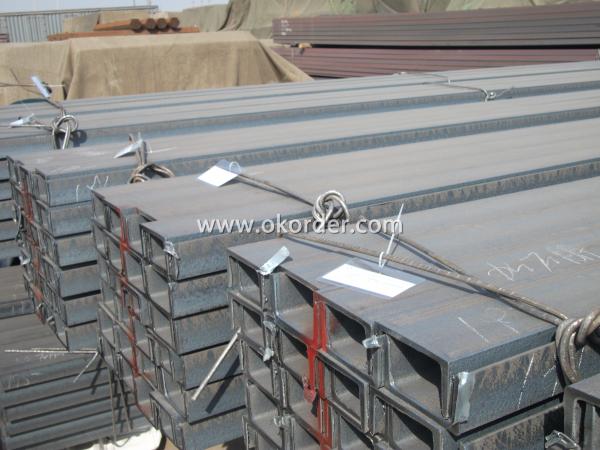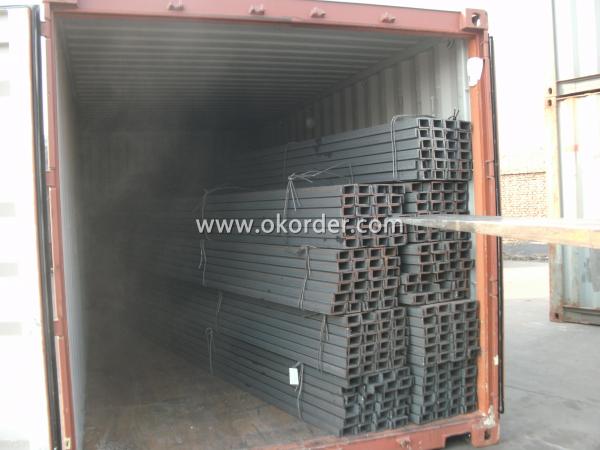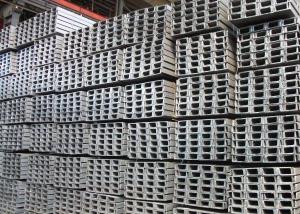Channel Steel
- Loading Port:
- Xingang Port
- Payment Terms:
- TT or LC
- Min Order Qty:
- 25 m.t.
- Supply Capability:
- 80000MTS/YEAR m.t./month
OKorder Service Pledge
OKorder Financial Service
You Might Also Like
Specifications of Channel Steel:
| Original Place | Tangshan, China | Brand Name | Bridge |
| Standard | GB707-88, EN100025, JIS G3192, DIN 1026 | ||
| Sizes | 50mm to 300mm | ||
| Sales Volume/Year | 3000MT | ||
| Main Market | Middle East, Africa, Southeast As | ||
1.We are able to provide channel steel of top quality at attractive price.
2.Our products of channel steel have passed ISO9001:2008 Quality Management System Certification.
3. The section of JIS Standard Channel Steel are as followings in the table.
| JIS U CHANNEL | Standard
h |
Sectional
b |
Dimension
s |
t |
Mass:
Kg/m |
| (mm) | (mm) | (mm) | (mm) | ||
| 50x25 | 50 | 25 | 3.0 | 6.00 | 2.37 |
| 75X40 | 75 | 40 | 3.8 | 7.00 | 5.30 |
| 75X40 | 75 | 40 | 4.0 | 7.00 | 5.60 |
| 75X40 | 75 | 40 | 4.5 | 7.00 | 5.85 |
| 75X40 | 75 | 40 | 5.0 | 7.00 | 6.92 |
| 100X50 | 100 | 50 | 3.8 | 6.00 | 7.30 |
| 100X50 | 100 | 50 | 4.2 | 6.00 | 8.03 |
| 100X50 | 100 | 50 | 4.5 | 7.50 | 8.97 |
| 100X50 | 100 | 50 | 5.0 | 7.50 | 9.36 |
| 125X65 | 125 | 65 | 5.2 | 6.80 | 11.66 |
| 125X65 | 125 | 65 | 5.3 | 6.80 | 12.17 |
| 125X65 | 125 | 65 | 5.5 | 8.00 | 12.91 |
| 125X65 | 125 | 65 | 6.0 | 8.00 | 13.40 |
| 150x75 | 150 | 75 | 5.5 | 7.30 | 14.66 |
| 150x75 | 150 | 75 | 5.7 | 10.00 | 16.71 |
| 150x75 | 150 | 75 | 6.0 | 10.00 | 17.90 |
| 150x75 | 150 | 75 | 6.5 | 10.00 | 18.60 |
4. Chemical Compostion of JIS Standard Channel Steel
| Grade | Element(%) | |||
| C | Mn | P | S | |
| SS330 | -- | -- | ≦0.050 | ≦0.050 |
| SS400 | ||||
| SS490 | ||||
| SS540 | ≦0.30 | ≦1.60 | ≦0.040 | ≦0.040 |
Usage/Applications of Channel Steel:
Channel Steel is usually used for building structure, vehicle manufacturing and other industrial structure and often used with i beam.
In details, the channel steel belongs to carbon structural steel which is applied to in the field of construction and machinery. The channel steel is usually used for arch-itechtural structure, and they could be welded in order to support or hang a vari-ety of facilities. They are also usually used in combination with I beam. Generally,the channel steel must possess perfect welding property, riveting property and mechanical property and so on.
Package & Delivery of Channel Steel:
The steel u channel will be packed in bundle with steel wire at each end of every bundle and color marking in order to help the customer to recognize his goods more easily at sight.
And steel u channel could be loaded into 20ft or 40ft container, or by bulk cargo. If the weight of each bundle reaches less than 3.5 mt, the loading by break bulk cargo should be choosed. When the weight of each bundle reaches less than 3mt, the loading by container should be choosed.
As for the transportaion from mill to loading port, the truck will be usually used. And the maximum quantity for each truck is 40mt.
All in all, we could do in accordance with customer's request.


Production Flow of Channel Steel:
1.The steel billet shall be heated in the high temperature furnace.
2. The heated steel billet shall be rolled five to nine times with the aim of shaping the general figure of steel u channel.
3. The rolled steel u channel should be put onto the cooling bed to make the temperature low.
4. The steel u channel should be straighted on the straightener.
5. The straighted steel u channel will be cut into meters by saw, as per customer's requirements.
- Q:Can steel channels be used in temporary structures?
- Indeed, steel channels are well-suited for temporary structures. Due to their robustness and endurance, steel channels find widespread use in construction. Their adaptability allows for effortless assembly and disassembly, rendering them perfect for temporary structures. Notably, steel channels offer both structural reinforcement and stability, making them an optimal choice for temporary bridges, scaffolding, and shoring systems. Moreover, their ability to withstand diverse weather conditions and resist corrosion adds to their dependability when utilized in structures that may be exposed to the elements.
- Q:What are the different methods of rust prevention for steel channels?
- There are several methods available for rust prevention in steel channels. Here are some of the most common ones: 1. Galvanization: This is a popular method where the steel channels are coated with a layer of zinc. The zinc acts as a sacrificial anode, protecting the steel from corrosion. Galvanization can be done through hot-dip galvanizing or electro-galvanizing, depending on the specific requirements. 2. Paint or Powder Coating: Applying a layer of paint or powder coating to the steel channels creates a barrier between the metal and the environment. This prevents moisture and oxygen from reaching the steel surface, thus inhibiting rust formation. The coating should be done properly, with thorough surface preparation and the use of high-quality anti-corrosion paints. 3. Epoxy Coating: Epoxy coatings provide excellent protection against rust and corrosion. These coatings are applied as a two-part system, consisting of a resin and a hardener. Epoxy coatings are known for their durability, chemical resistance, and ability to adhere well to steel surfaces. 4. Cathodic Protection: This method involves the use of a sacrificial anode or impressed current to protect the steel channels from rust. Sacrificial anodes, usually made of zinc or aluminum, are connected to the steel channels and corrode in place of the channels. Impressed current systems use an external power supply to create a protective electric current that prevents corrosion. 5. Rust Inhibitors: These are chemical compounds that can be applied to the steel channels to inhibit rust formation. Rust inhibitors work by forming a protective layer on the metal surface, preventing moisture and oxygen from reaching the steel. These inhibitors can be applied as a spray, dip, or by incorporating them into coatings or paints. It is important to choose the appropriate rust prevention method based on the specific application, environmental conditions, and budget constraints. Regular maintenance and inspection of the steel channels are also crucial to identify and address any signs of rust or corrosion in a timely manner.
- Q:Can steel channels be used in the automotive parts manufacturing industry?
- Indeed, the automotive parts manufacturing industry does utilize steel channels. Within the automotive industry, steel channels find widespread application in structural components, frames, body panels, reinforcements, and chassis parts. Their remarkable strength and durability render them apt for enduring the rigorous conditions and loads confronted by automotive parts. Moreover, steel channels boast the advantage of effortless shaping, cutting, and welding, enabling efficient customization and fabrication of automotive components. By incorporating steel channels, the automotive parts manufacturing industry guarantees the production of sturdy and dependable automotive parts.
- Q:How do steel channels perform under extreme weather conditions?
- Steel channels are known for their durability and strength, which makes them well-suited to withstand extreme weather conditions. Their high tensile strength allows them to resist bending or warping under heavy winds or intense heat. Additionally, steel channels have excellent corrosion resistance properties, making them highly resistant to rust or deterioration caused by extreme temperatures, moisture, or saltwater exposure. Overall, steel channels are reliable and perform exceptionally well under extreme weather conditions.
- Q:What are the weight limitations of steel channels?
- The weight limitations of steel channels vary depending on their dimensions, thickness, and the specific grade of steel used. It is important to refer to the manufacturer's specifications or consult with an engineer to determine the maximum weight that a particular steel channel can support safely.
- Q:What is the typical lifespan of steel channels?
- The lifespan of steel channels can differ depending on various factors such as the quality of the steel used, the installation environment, and the level of maintenance they receive. On average, steel channels typically last between 20 and 50 years. Steel channels are widely utilized in construction and industrial settings because of their strength and durability. They are engineered to withstand heavy loads and offer structural support. However, over time, steel channels can undergo corrosion, wear and tear, and other forms of degradation. To extend the lifespan of steel channels, regular maintenance and protective measures are crucial. This includes conducting routine inspections, cleaning, and applying protective coatings or treatments to prevent corrosion. In addition, proper handling, installation, and load management practices can also contribute to prolonging their lifespan. It is important to recognize that the specific lifespan of steel channels can vary based on the specific conditions they encounter. For example, steel channels installed in coastal areas with high levels of saltwater exposure may experience faster corrosion and a shorter lifespan compared to those installed in inland regions. To determine the expected lifespan of steel channels for a particular application, it is advisable to seek guidance from structural engineers, manufacturers, or industry experts who can provide insights based on the specific project requirements and conditions.
- Q:How do steel channels contribute to the overall cost-effectiveness of a project?
- Steel channels contribute to the overall cost-effectiveness of a project in several ways. Firstly, steel channels are known for their durability and strength, which means they have a longer lifespan compared to other materials. This results in reduced maintenance and replacement costs over time, thus saving money in the long run. Additionally, steel channels are lightweight yet robust, making them easier and more cost-effective to transport and handle during construction. This can reduce labor and transportation costs, as well as the need for heavy machinery, ultimately contributing to overall cost savings. Moreover, steel channels are versatile and can be easily fabricated to meet specific project requirements. Their adaptability allows for efficient customization, eliminating wastage and reducing material costs. Furthermore, steel channels have excellent corrosion resistance properties, reducing the need for regular maintenance and extending their lifespan, thus providing additional cost savings. Furthermore, steel channels are often produced using recycled steel, which is not only environmentally friendly but also cost-effective. By utilizing recycled materials, the overall cost of production can be reduced, making steel channels a more affordable choice for construction projects. Lastly, steel channels offer a high strength-to-weight ratio, meaning fewer materials are needed to achieve the same structural integrity compared to other materials. This results in cost savings in terms of material procurement and construction time, as less material needs to be installed. In conclusion, steel channels contribute to the overall cost-effectiveness of a project by providing durability, lightweight characteristics, adaptability, corrosion resistance, and the potential for using recycled materials. By considering these factors, the use of steel channels in construction projects can lead to significant cost savings, making them a cost-effective choice for various applications.
- Q:How do steel channels contribute to the overall safety of a structure during earthquakes?
- Steel channels contribute to the overall safety of a structure during earthquakes by providing additional structural support and resistance to lateral forces. They help distribute the seismic energy more evenly throughout the structure, preventing localized damage and potential collapse. The channels act as bracing elements, increasing the stiffness and rigidity of the building, which reduces the chances of structural failure during seismic events.
- Q:What are the different methods for protecting steel channels from chemical exposure?
- There are several methods available for protecting steel channels from chemical exposure. These methods aim to prevent corrosion and deterioration of the steel, ensuring its longevity and structural integrity. Some of the common methods include: 1. Coatings: Applying protective coatings on the steel channels is an effective way to safeguard them from chemical exposure. Various types of coatings such as epoxy, polyurethane, and zinc-rich coatings can be used. These coatings act as a barrier between the steel and the corrosive chemicals, preventing direct contact and potential damage. 2. Galvanizing: Galvanizing involves coating the steel channels with a layer of zinc. This process creates a protective barrier that prevents chemical substances from reaching the steel surface. It is often used in environments where the steel channels are exposed to harsh chemicals or corrosive elements. 3. Plastic encapsulation: Another method to protect steel channels from chemical exposure is by using plastic encapsulation. This involves wrapping the steel channels with a plastic coating or sheath. The plastic acts as a barrier, shielding the steel from direct contact with chemicals and preventing corrosion. 4. Alloying: Alloying is a technique where steel is mixed with other metals or elements to enhance its resistance to chemical exposure. By adding specific alloying elements such as chromium, nickel, or molybdenum, the steel channels can become more resistant to corrosion and chemical attack. This method is commonly used in industries where steel channels are exposed to aggressive chemicals. 5. Cathodic protection: Cathodic protection is a method that involves using sacrificial anodes or impressed current to protect steel channels from corrosion. This technique creates an electrochemical reaction that prevents the steel from corroding. It is particularly useful in environments where the steel channels are submerged in water or come into contact with corrosive liquids. 6. Proper maintenance: Regular maintenance is crucial for protecting steel channels from chemical exposure. This includes cleaning any chemical spills or residues promptly, inspecting the channels for signs of corrosion, and applying protective coatings as needed. Maintaining a clean and dry environment around the steel channels can also help minimize the risk of chemical damage. It is important to consider the specific requirements of the environment and the type of chemicals the steel channels will be exposed to when choosing a protection method. Consulting with experts or professionals in the field can help determine the most suitable method for ensuring the long-term protection of steel channels from chemical exposure.
- Q:What are the different applications of steel channels?
- There are numerous industries that make use of steel channels for various applications. Here are some examples of how steel channels are utilized: 1. In the construction industry, steel channels are widely utilized for different structural purposes. They serve as beams, columns, and purlins in building frames, providing exceptional strength and stability to support heavy loads. 2. When it comes to infrastructure, steel channels play a vital role. They are crucial in the construction of bridges, flyovers, and highways, offering essential support and reinforcement to these structures. 3. The manufacturing industry also relies on steel channels for creating frames, racks, and supports for machinery and equipment. These channels are commonly used in industrial warehouses and factories to establish a sturdy framework for storage systems and production lines. 4. In the automotive industry, steel channels are extensively used for manufacturing various vehicle components, including chassis, frames, and suspension systems. They possess high strength and durability, ensuring the safety and stability of vehicles. 5. Within the electrical industry, steel channels are employed for cable management and support systems. They provide a secure and robust pathway for electrical wires and cables, ensuring proper organization and protection against damage. 6. Steel channels also find applications in the marine industry due to their corrosion resistance properties. They are utilized in the construction of ships, boats, and offshore structures, offering structural support and withstanding the harsh marine environment. 7. Furniture manufacturing often involves the utilization of steel channels, particularly in the creation of metal frames for chairs, tables, and shelving units. These channels offer stability and durability, making them ideal for heavy-duty furniture designs. 8. In the agricultural sector, steel channels are employed for various purposes. They serve as support structures for greenhouses and can also be used for creating sturdy fencing systems. Overall, steel channels are versatile structural components that have a wide range of applications across different industries. Their strength, durability, and versatility make them a preferred choice for construction and manufacturing purposes.
1. Manufacturer Overview |
|
|---|---|
| Location | Hebei, China |
| Year Established | 1993 |
| Annual Output Value | Above US$100 Million |
| Main Markets | South Asia Middle East; Southeast Aisa; south Korea |
| Company Certifications | ISO 9001:2000 |
2. Manufacturer Certificates |
|
|---|---|
| a) Certification Name | |
| Range | |
| Reference | |
| Validity Period | |
3. Manufacturer Capability |
|
|---|---|
| a)Trade Capacity | |
| Nearest Port | Tianjin; |
| Export Percentage | 1% - 10% |
| No.of Employees in Trade Department | 11-20 People |
| Language Spoken: | English; Chinese |
| b)Factory Information | |
| Factory Size: | Above 20,000 square meters |
| No. of Production Lines | 1 |
| Contract Manufacturing | OEM service offered |
| Product Price Range | average |
Send your message to us
Channel Steel
- Loading Port:
- Xingang Port
- Payment Terms:
- TT or LC
- Min Order Qty:
- 25 m.t.
- Supply Capability:
- 80000MTS/YEAR m.t./month
OKorder Service Pledge
OKorder Financial Service
Similar products
New products
Hot products
Related keywords




























